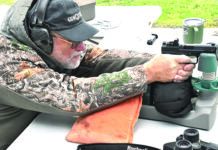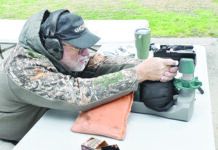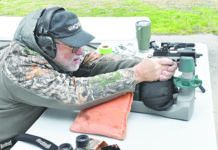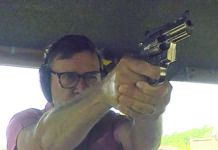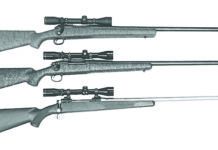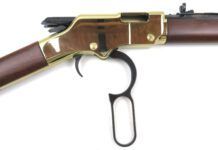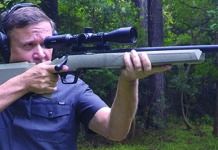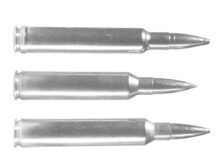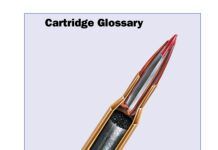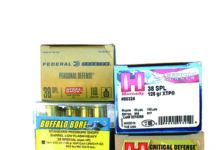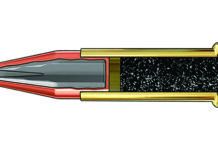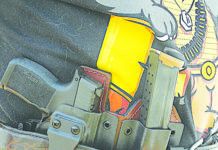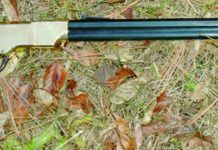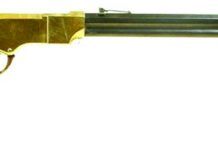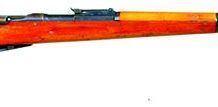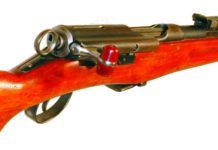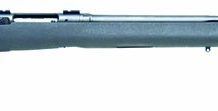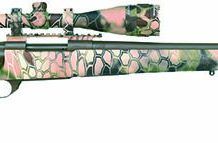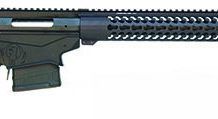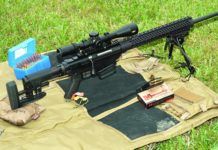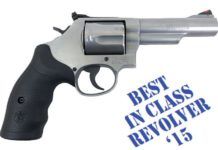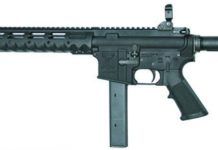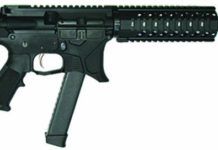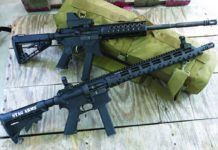Ubertis 1860 Henry Rifle Trumps Henrys Original Lever-Action
In our October 2015 issue, we took a hard look at the Henry Repeating Arms' "Original Rifle" in a test that included a Winchester 1892, both rifles in 44-40 WCF. The Winchester won a clear victory in that head-to-head test of lever actions, but we were intrigued by the Henry nonetheless. The Henry rifle worked well enough but had a nasty job of overbuffing, we thought, that gave the brass action a mirror polish at the expense of destroying the edges of the octagonal flats of the barrel. The overbuffing also left a depression, sometimes called a "hog wallow," where the barrel met the 5-inch sleeve at the muzzle. Partly because of that problem and partly because of the high price, $2300, we gave the rifle a Grade: C rating. That's not enough recommendation for us to invest in the Henry "Original," so we began looking for a similarly styled levergun and found the Uberti version of 1860 Henry for a lot less money.
Because the availability of 44-40 ammunition choices is fairly tight (MidwayUSA.com lists 10 choices, with only lead bullets, in weights from 200 to 225 grains), we figured if we found an 1860 we liked, we'd prefer to have a wider range of loads for it, so we acquired one chambered in 45 Colt (aka Long Colt), for which MidwayUSA.com lists 56 results, in bullet weights from 145 grains to 360 grains in lead, copper, even shotshells. Looking at these 1860s point by point, we realized we were looking for a rifle that would trump Henry's Henry — and it would be no easy task for the Uberti to take down the namesake 1860. Here's what we found.
Uberti Model 1860 Henry 342880 45 LC, $1429
Uberti makes five versions of this rifle. The Trapper 342910 in 45 Colt has an 18.5-inch barrel, a brass frame and buttplate, and a case-hardened lever. The Rifle models have similar cosmetics to the Trapper but have 24.5-inch barrels, one chambered in 44-40 (342390) and our test gun in 45 Colt. Two more Rifle models come in the same chamberings (342370 in 44-40 and 342360 in 45 Colt) and have the same barrel lengths as the brass ones, but they display case-hardened frames and levers and blued buttplates and list for $30 more. Our first glance at the Uberti test model was extremely satisfying. We found the barrel flats to be properly done. The edges between them were sharp enough and, sighting along the flats, we found them to be dead level. The bluing was authentic looking. It was not rust bluing, but looked close enough to it to satisfy us. Our impression was that this is how the 1860 Henry is supposed to look. While the action was not quite so glossy as the Henry version, it still reflected much like a mirror and was, like the barrel flats, dead flat. The walnut stock had some lovely tiger-striping in it that our photos might not pick up, and inletting was excellent. While the stock finish was mighty hard, it had none of the milkiness that Henry's rifle had.
The little button behind the loading lever had distinct stops every 90 degrees, a feature was missing from the previously tested version. The sights were identical to those found on the Henry Henry, the rear having all the same little cuts, holes, notch contours, elevation slide and markings as on the other rifle. The front sight was also identical in contour to the other rifle, and had a flat-topped blade insert of somewhat shiny metal. The hammer was blued, but the loading lever was case hardened. We believe the original Henry rifles (from the 19th century) had blued parts, but there were some finish variations in the 1866 and 1873 rifles that followed it, so we believe it's possible some of the original Henrys had case-hardened parts. If that's not true and the dull case coloring offends you, rub the parts with cold blue and call it good. We don't think that's necessary, however — it looked mighty nice.
Rifle Stats: Schmidt-Rubin M1911 7.5X55mm Swiss, $350
Once again we have a really snappy example of the species for our test. The bore, all 30.7 inches of it, looked like it was new. The muzzle was fitted with a clever snap-over cap, made of brass and spring steel, to keep crud out. The light-colored stock, most likely some form of birch, was decent looking with what seemed to be its original finish, though it had plenty of small dings and nicks. The metalwork and bluing were also in very good condition, retaining about 90 percent finish. The detachable magazine held six rounds and was extremely easy to load. We thought the metal finish was pretty good, not a shiny finish nor entirely dull, most certainly not crude, generally well done, and essentially equal to the finish on many modern rifles.
Rudolf Schmidt designed this action, and the great Swiss craftsmen brought it into a viable form that lasted a long time. To operate the rifle, the soldier did not have to learn how to twist a conventional bolt. All he had to do was grab the twin knobs on the right side of the action, heave them straight back, and shove them straight forward. This was undoubtedly faster for the average man to operate than all but the most skilled conventional-bolt operators. We kept trying to twist the lever downward after a new round went home, but we quickly adapted. Despite the great length of the rifle we did not find it to be clumsy, though it took some getting used to its 51.5 inches of length. We thought the sights were on the small size for fastest use, but serviceable. The rear was graduated out to 2000 yards and had a small U-notch, and the front was a flat-top post in a dovetail. The stock went almost all the way to the muzzle, and covered the barrel all the way but for the last 2.5 inches. That long, slim stock was just over 48 inches long. It was of hard wood, and had a pistol-grip insert added. The upper hand guard was just over 21 inches long. There was a bayonet lug on the forward barrel band and a stacking hook under the muzzle affixed to that same band. The forward barrel band was inletted into the wood. It was fitted with a stout screw to retain it, and opposite the screw was a hinge to permit removal of the band. All the visible numbers were matching including on the magazine. Even the curved and coned steel butt plate held the last three digits of the serial number.
A Superb Straight-Pull Vintage Rifle
Our test rifle here is a Schmidt-Rubin Model 1911. These rifles were made in a variety of models and lengths, including carbines, over the years as various small improvements came along to correct some of the initial shortcomings of the rifle. Commonly available on the U.S. surplus market for many years, the S-R never sold in vast quantities despite attractive prices, most likely because the ammo was somewhat hard to get and the action didn't permit transformation into a suitable sporterized form. Although the Schmidt-Rubin was not designed to be a sporter, we suspect a clever stock maker could make up a shorter-barrel version of this (carbines have 24-inch barrels) into an attractive custom rifle, much as Al Linden did long ago for the Krag. We tested our rifle with three types of ammo. This was Swiss Army issue GP11 with 174-grain FMJ bullets, Wolf soft-nose 174-grain bullets, and Hornady's 165-grain soft-nose load. Here's what we found.
Eduard Rubin ought to be a household name to gunnies the world over. Why? He invented the full-metal-jacketed bullet back in 1882. Oddly, the bullet was paper patched, much like the old lead bullets were patched for many years prior to that date, but his was apparently the first metal-jacketed bullet to be paper patched. This technique is still occasionally useful today to bump up a bullet's diameter to make it fit an odd bore size.
Along his way Mr. Rubin came up with several cartridge designs, his most famous being the 7.5x55 Swiss, which essentially has defended Switzerland since 1889. The cartridge in nearly identical form is still used today in the Swiss M51 machine gun, and by home reserve units. Today's version of the cartridge, known as the GP11, brought out in 1911 like our test rifle, uses a boat-tailed bullet of 174 grains. That ammunition played a big part in U.S. military cartridge development.
[IMGCAP(1)]
During the first World War, the then-current version of the 30-06, with 150-grain flat-base bullet, was found to give poor performance at long range. This was discovered after U.S.-made machine guns finally replaced the foreign-made ones the U.S. had been using. At the time, long-range cover or blanketing fire from machine guns was key to military operations, though that is not the case today. The original 30-06 ammo was supposed to have a maximum range of close to three miles. It was found to have a true range of less than two miles. After the war the U.S. was determined to fix that, and began serious testing. In the process the Swiss GP11 ammunition, with the same-diameter bullets, was evaluated and found to be vastly superior to the 30-06. In light of the great performance of the Swiss ammo at long range, the U.S. testing team loaded Swiss bullets into our 30-06 brass and found it to be far better than even the U.S.'s specially loaded 180-grain match ammo. It was thus determined the 30-06 needed a boat-tail bullet. But what angle should the boat-tail be?
Rifle Stats: Savage Arms Model 12 Long Range Precision (LRP) 19137 6.5 Creedmoor, $1252
The next movie about a military sniper may feature a rifle similar in construction to the Ruger Precision Rifle, but based on the accuracy and simplicity of the Long Range Precision Rifle Model 12, the specially bedded fiberglass stock is still the heavyweight champion, even if this platform is under attack from the chassis designs. The HS Precision Pro Series Tactical (PST) stock on the Savage grabs your attention, as do the LRP's 1-inch-diameter 26-inch-long fluted carbon-steel barrel, oversized bolt handle, and scrolled and polished chrome bolt.
Our test rifle model, No. 19137, was so new at the time of this writing that the manufacturer had not yet assigned a photograph to its web link. But it does resemble the $3695 HS Precision PLR custom rifle, though our test rifle offered a more vertical grip and the barrel of our LRP showed decidedly less taper. The heft of the barrel walls made the 6.5mm bore look relatively tiny, with the result being a rifle that was heavy but with a balance point very near the center of its 46-inch-plus overall length.
The Model 12 fed from a detachable magazine. We liked that it fit flush to the receiver, but magazine capacity was limited to only three rounds. Formed from sheet metal, the magazine's construction was robust. While feeding and working the action, we found it to be smooth and reliable, but also a bit heavy, in our view. The words, "Warning: Precision Target Trigger" were emblazoned on the left side of the action, and, yes, this was indeed a special iteration of Savage's Accu-Trigger. The center activation lever was also colored red to remind the shooter to pay extra attention. Our Savage LRP had the lightest-weight trigger in our test, coming in at about 2.25 pounds with little variation. The trigger sensation was very easy to learn, and it did not ask the shooter to overcome a sharp break or wait through a lengthy compression.
Rifle Stats: Howa 24 in. HB HKF92507KH+AB 6.5 Creedmoor, $1000
This is the list price. We found the package retailing for $795 atRichiesPNG.com, but it was also out of stock. You can find a retailer on the Legacy Sports website under Contact > USA Dealers.
Based on the company's 1500 action, the Howa rifle was the most straightforward in terms of profile, offering a Sporter-style Hogue Overmolded stock with an aluminum bedding block. It was treated to a Kryptek Highlander camouflage coating, as was the Nikko Stirling 4-16x44mm GameKing scope included in this package. The barreled action was sheathed in Austrian Brown Cerakote and free-floated, connecting to the stock with two pillars fore and aft of the trigger guard and the hinged floorplate of the magazine. The Howa rifle felt quite rigid, and the surface of the stock was friendly to the hands and cheek. A beefy rubber buttpad was mounted, and there were sling swivels front and rear. The forend of the stock was broad enough to make good contact with a sandbag or any other surface. The No. 6-profile heavy barrel was 24 inches long. The result was a heavyweight hunting rifle (9.5 pounds loaded) with a commanding presence.
We couldn't help but notice that Ruger's Marksman adjustable trigger looks and acts very much like Savage's AccuTrigger, each with a hinged lever integrated with the trigger face. Howa's two-stage HACT (Howa Actuator Controlled Trigger) looked common in comparison, but is renowned in its own right. The Howa HACT trigger offered a short take up to a soft, but predictable, break. Measured using a Lyman digital scale, weight of resistance averaged just under 2.6 pounds, with a maximum deviation of no more than 6 ounces. At no time did anyone on our team find the fluctuation so obvious that it affected accuracy or the shooting experience in general. One member of our team thought the trigger was further to the rear than they liked.
Rifle Stats: Ruger Precision Rifle 18005 6.5 Creedmoor, $1399
First reactions to the Ruger Precision Rifle ranged from "It's a bolt-action AR" to the expectation that the RPR was a "chassis" rifle. Actually, nether is correct, but the RPR draws from both of these platforms. A chassis rifle consists of a frame, including a buttstock, folding or rigid, and support structure for the barreled action, trigger mechanism, and magazine well connected to a forend that may or may not be skeletonized, but provides bore-centric rails for mounting optics, laser aiming devices, or illumination. A true chassis rifle, such as those made by Accuracy International, JPRifles or Ashbury Precision Ordnance, provides a complete structure into which a barreled action is bolted in place. If the RPR were a true chassis rifle, then maybe the barreled action from one of Ruger's three Hawkeye bolt-action rifles chambered for 6.5 Creedmoor would fall right into place. But the Ruger Precision Rifle is more of a hybrid design built around Ruger's patented American-style action and the company's SR AR-15/type rifles.
Nonetheless, the RPR takes advantage of the many AR-like features that the American public has fallen in love with. The 15-inch-long Samson key-mod free-float handguard is ready to accept Picatinny rails in just about any position the operator desires. The top rail was affixed at 12 o'clock and extended the 7.8-inch-long Picatinny rail directly above the receiver. Bore-to-rail height was very close, and recoil was designed to move straight to the rear at the top of the 0.9-inch-thick rubber buttpad. The buttpad was designed to be adjustable for cant, but we found the primary locking screw to be frozen and were unable to move it from its vertical set. Adjustment for length of pull was much easier via a cam and clamping lever. With the release lever pulled away from the rifle, the buttpad could be moved closer to or further from the receiver by rotating the large threaded shaft. Despite variations in size, each staff member was able to adjust for eye relief and comfortable extension of the arms and wrists.
6.5 Creedmoor Bolt Action Rifle Comparison
Reading Gun Tests means having a front-row seat to watch the evolution of firearms. But it's rare that so much change is represented within a single roster. In this test we'll compare three bolt-action rifles with what we call traditional, modern, and progressive designs. Even with its Kryptek camouflage coating and heavy barrel, the $1000 Howa 1500 from Legacy Sports International filled the traditional role with a standard-profile stock, bolt, trigger, and safety. The newest version of the $1252 Savage Model 12 LRP series was aptly named because it mirrors the modern long range precision rifle. The $1399 Ruger Precision Rifle progresses the idea of a precision military or competition rifle built around the ergonomics of the AR-15 rifle in mass production for a mass-production price.What ties these rifles together is the 6.5 Creedmoor chambering, which was named — if not designed for — the famed Creedmoor Cup rifle competition. The Creedmoor Cup is a three-day event consisting of 16 different matches with a total of 240 shots fired standing, seated, and prone at distances of 200 yards, 300 yards, and 600 yards. The essence of the 6.5 Creedmoor round is a 6.5mm (0.264-inch diameter) bullet launched with approximately the same velocity and relatively flat trajectory of the 300 Winchester Magnum, but with considerably less recoil. This is important because, unlike hunters, competitive shooters need to be able to withstand the recoil of hundreds of rounds during matches and practice.
Not every maker is currently producing 6.5 Creedmoor, but based solely on available choices, Hornady Manufacturing is the most prolific. Our test rounds were Hornady's 129-grain SST Superformance hunting load, plus Hornady's 140-gain A-Max, and 120-grain A-Max Match rounds. We also tried handloading equivalent ammunition consisting of once-fired Hornady brass and 140-grain Hornady A-Max bullets to learn more about the cartridge. However we were limited in overall cartridge length to suit the detachable magazines of the Ruger Precision Rifle.
The Howa arrived with its own scope in place and with camouflage finish to match, but to put each gun on equal footing at the range, we shot our test rounds with Bushnell's new 2.5-18x44 Long Range Hunting Scope featuring 30mm tube construction, 0.25-MOA click value, and the innovative 62M reticle. Bushnell's Tactical Hunter series scopes feature first-focal-plane magnification, which means you can keep the reticle lines small to block only a minimum amount of target. Accuracy data was collected by shooting 5-shot groups from the 100-yard bench at Houston's American Shooting Centers. We are aware that the 3-shot group is being used as the standard elsewhere, including within the rules of Ruger's Precision Rifle challenge, but we like the 5-shot standard better because it says more about heat management and how the shooter is helped or hindered throughout the rigors of multiple shots. Here's how the rifles performed for our shooters.
2015 Guns & Gear ‘A’ List
Toward the end of each year, I survey the work R.K. Campbell, Roger Eckstine, Austin Miller, Ray Ordorica, Robert Sadowski, David Tannahill, Tracey Taylor, John Taylor, Rafael Urista, Ralph Winingham, and Kevin Winkle have done in Gun Tests, with an eye toward selecting guns, accessories, and ammunition the magazine's testers have endorsed. From these evaluations I pick the best from a full year's worth of tests and distill recommendations for readers, who often use them as shopping guides. These choices are a mixture of our original tests and other information I've compiled during the year. After we roll high-rated test products into long-term testing, I keep tabs on how those guns do, and if the firearms and accessories continue performing well, then I have confidence including them in this wrap-up.— Todd Woodard
Rifle Stats: Stag Arms Model 9T 9mm Luger, $1,275
A well-made and well-equipped rifle out of the box. The 9T offered a slightly better trigger pull and slimmer,more-user-friendly handguard.
Rifle Stats: Tresna Defense JAG9G BU 9mm Luger, $1,100
This is a quality rifle with good accuracy and the added benefit of being compatible with Glock 9mm magazines of any size.
Pistol-Caliber ARs: We Pit the Stag Arms 9T, Tresna Defense
Carbines chambered in 9mm with AR-15 controls have been around since the 1980s, when Colt developed the Colt SMG, a select-fire carbine. Since military and LE agencies were familiar with the AR platform, it made sense to create a rifle that offered less penetration, less perceived recoil, less muzzle blast, and better short-range control.
Today's advances in ammunition technology has nearly made the overpenetration problem moot. Load an AR chambered in 5.56x45mm NATO with the right bullets and you can control overpenetration, and, of course, the same can also be said with newer 9mm ammo. However, if you're trying to decide on whether to add a 5.56 carbine or a 9mm carbine to your home-defense plans, the muzzle blast from the 5.56x45mm NATO causes some shooters to flinch. The 9mm produces nowhere near the muzzle blast. You pay a penalty for that ballistically, because there is a chasm between the 9mm pistol round and the 5.56 rifle round, which is why the Colt SMG was and is primarily used as an entry weapon to provide a high volume of firepower that can be effectively controlled. If you can't decide, there are plenty of kits that allow a user to adapt a 5.56 AR lower and put on a 9mm upper receiver and a drop-in magazine block to make the 5.56 magwell compatible with 9mm magazines.
What a 9mm AR really offers is a long gun and handgun that share the same ammo. That concept has been around since the days of the Old West because it made sense then and it makes sense today. Another factor to consider is ammunition cost; 9mm ammo, in some cases, is nearly half the cost of 5.56 ammo, and a fairly good assortment of 9mm can usually and easily be found in big-box stores as well as your local mom-and-pop gun store. These rifles also offer nearly the same amount of customization as a standard AR-15 carbine — pistol grips, handguards, BUIS, optics, charging handles, safety selectors, triggers, muzzle devices — allowing nearly an unlimited amount of personalization.
We recently tested two 9mm ARs that look like and have the same controls as an AR-15, but their operating systems were quite different. The Stag Arms 9T and the Tresna Defense JAG9G BU use simple blowback mechanisms, not a gas-impingement system or a gas piston system like on an AR-15/M16 rifle or carbine. In a blowback action, there is no gas block, gas tube, or a piston, and the bolt-carrier group is noticeably different. The AR's bolt-carrier key is not needed, and the bolt carrier is heavier on a 9mm AR compared to a traditional AR-15 bolt carrier. Because the blowback system works off the resistance of the bolt and recoil/buffer spring, a heavier bolt carrier is required. You can feel the effect when the rifle cycles. The bolt and recoil spring move rearward from the force of a shot fired to eject the empty case and cock the hammer. They then move forward via the recoil spring in the buffer tube, with the bolt pushing a cartridge out of the magazine and ramming it into the chamber.
Since 2003, Stag Arms, located in Connecticut, has been manufacturing Mil-Spec AR-15 rifles in a variety of furniture and caliber options; in addition to 9mm, the company offers 5.56mm, 300 BLK, 6.8 SPC, and 22 LR. Stag also makes left-hand variants with the ejection port located on the left side of the rifle. Stag Arms manufactures 80 percent of its parts in house, with only the plastic pieces and some of the small springs manufactured by other vendors. Tresna Defense introduced its civilian rifles in 2014. Located in Georgia, Tresna (which means tool in Basque) makes models compatible with 9mm or 40 S&W magazines from either Glock or S&W M&P pistols. So, depending on your handgun brand and caliber preference, you can have a Tresna rifle that uses the same magazine.
Both of these ARs are dedicated 9mm platforms, meaning they are built specifically to fire 9mm ammo with a dedicated 9mm upper and lower. There are other similarities. Both featured a 16-inch barrel with an A2-style flash hider, A2-style pistol grip, single-stage trigger, and each came in a hard case with one magazine. From there, the rifles' features diverge. The biggest difference between these two rifles is the Stag Arms uses a Colt-style stick magazine, while the Tresna Defense uses Glock Gen4 9mm magazines. We found that the ability to use the same magazines in our handguns and rifles offered a lot of flexibility. Another difference is the Stag Arms 9T is ready to be used out of the box, due to the flip-up sights being included. The Tresna Defense JAG9G BU does not come with sights, so that can become another way for consumers to separate these two highly-ranked products.


